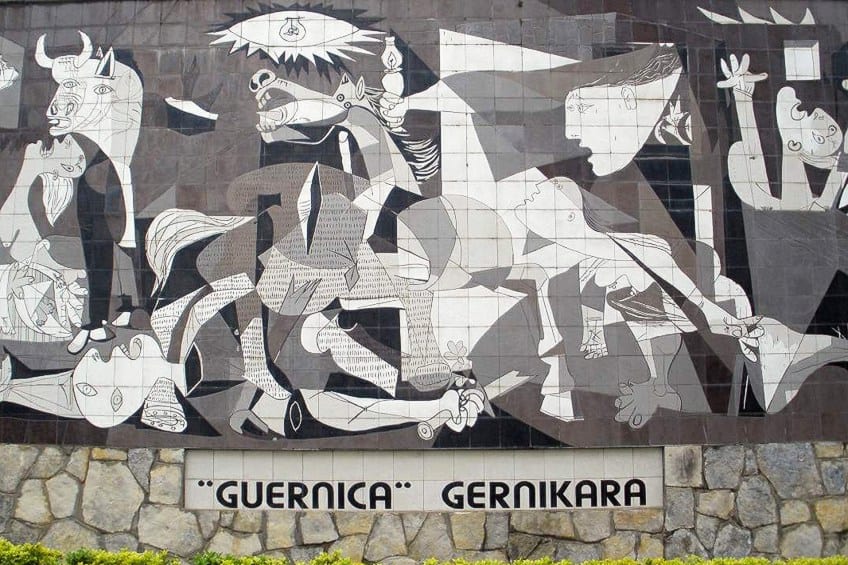“Guernica” by Picasso – The Iconic Spanish Civil War Painting
Guernica by Picasso is one of the artist’s most famous paintings. With the Guernica painting, Picasso made a very powerful political statement. This art of war was painted during the Spanish civil war immediately after the Nazi’s disastrous bombing of the town of Guernica. Let us look at Guernica’s meaning of Picasso’s Guernica to understand the question, “why did Picasso paint Guernica?” In this article, we will do a formal analysis of the Spanish Civil War painting, Guernica by Picasso, and also look at the impact it had on the art world and its audience at the time.
Artist Abstract: Who Was Pablo Picasso?
Born in Málaga, Spain, on the 25th of October, 1881, Pablo Picasso was baptized with about fifteen names – many of them after saints and biblical characters. His family was not rich, or poor, but were an esteemed family in their community. They loved art and culture – his father also painted and taught drawing.
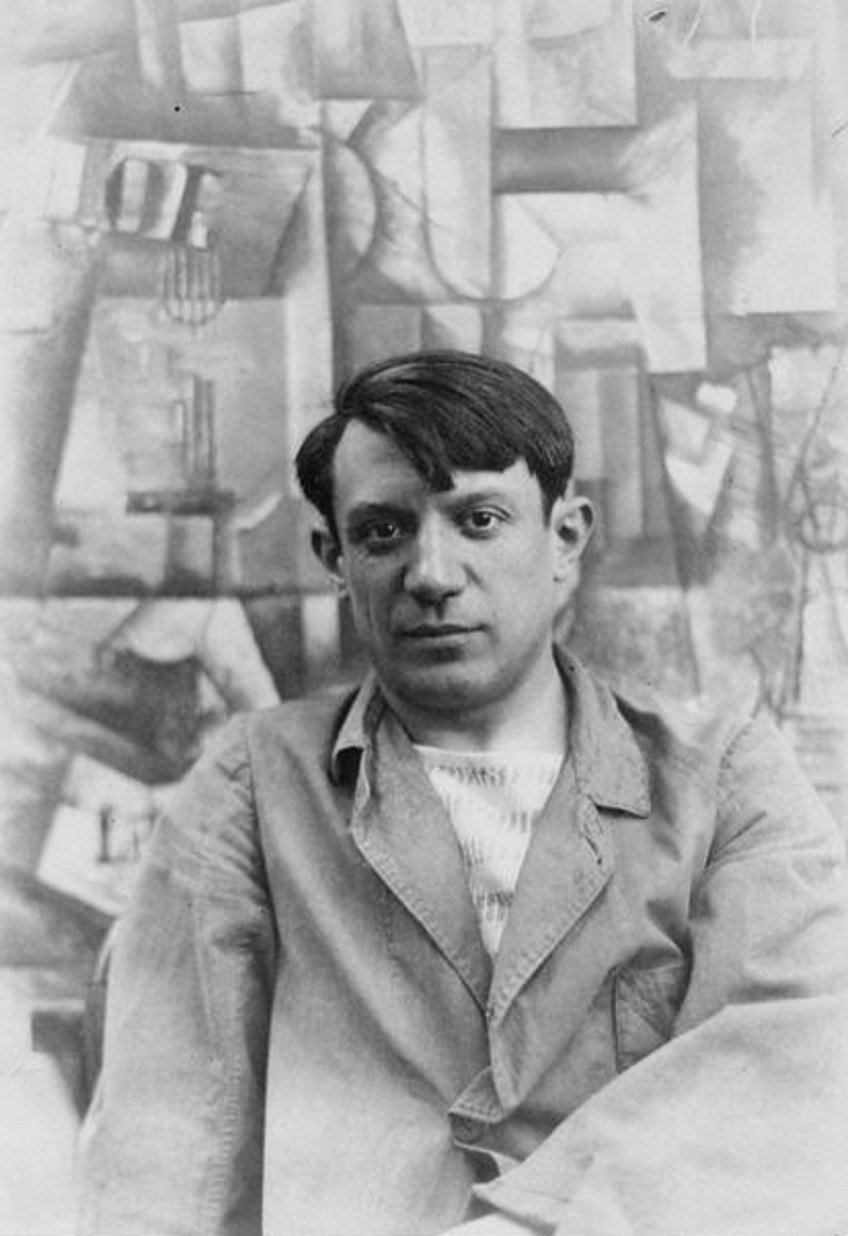
This was a stroke of luck, as Picasso did not enjoy schoolwork and was only interested in drawing. His father started instructing him in the art of traditional naturalistic drawing from a young age. When Picasso went to the San Fernando Fine Art Royal Academy, he already had a vast knowledge and skillset of art practice. He finished his education very quickly. This helped him achieve his first success in exhibitions before the age of twenty-one.
He moved to Paris at the age of nineteen, and although he was not really known outside of Barcelona, he had already produced many paintings.
He went through a rough period emotionally and financially in the first few years he lived there. This period of his life is characterized by the painting series called the Blue Period (1901 – 1904). He then had his Rose Period (1904 – 1906) as well where he painted predominantly in pink, Picasso created the controversial Les Demoiselles d’Avignon (1907). His career changed forever as he started the Cubist movement after that and became famous in his lifetime as one of the fathers of Modern art.
Pablo Picasso Today
Most people in the world know the name Pablo Picasso (1881 – 1971). In recent years, his perpetual fame has been drawn into question by movements like #MeToo. A lot of women have argued recently that Picasso should not enjoy such glorified fame, with his granddaughter Marina Picasso writing that he submitted his wives, many mistresses, and lovers to his “animal sexuality, tamed them, bewitched them, ingested them, and crushed them onto his canvas.”
This issue brings up a lot of problems in the Western art canon mostly built around European men, and begs the question, “can art be separated from the artist?”
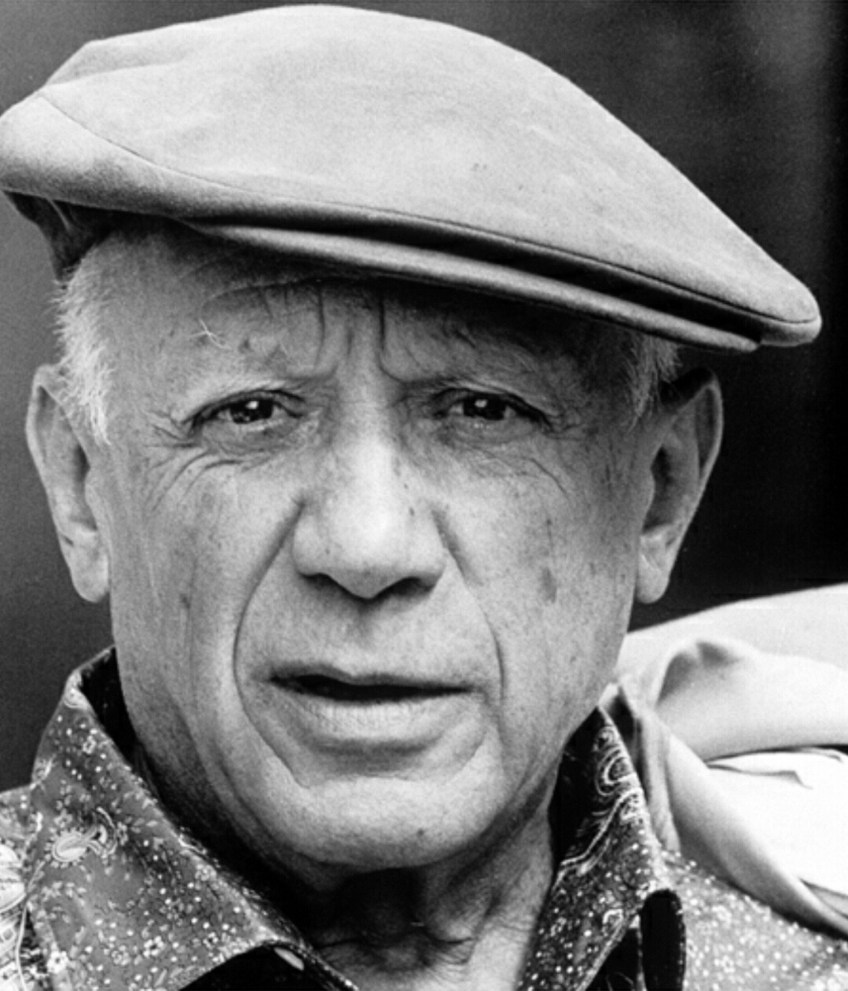
Picasso played a massive role in the formation of modern art. His influence would lead many artists that followed to express themselves with much more ease and freedom. This artist is still largely celebrated throughout the world, with collections of his work seen in most major international art museums. Keeping his strange history with women in mind, we can still consider the impact of this artist’s body of paintings.
Guernica’s meaning, for example, and the impact it had on the way war was perceived is an example of the positive impact Picasso’s work had on society.
Guernica by Picasso: An Analysis
| Artist | Pablo Picasso (1881 – 1973) |
| Date | 1937 |
| Medium | Oil on canvas |
| Dimensions (m) | 3.49 x 7.77 |
| Art Movement | Cubism |
| Location | Museo Reina Sofia, Madrid, Spain |
So, why did Picasso paint Guernica (1937)? This Spanish civil war painting became Picasso’s most important political work of art. It became an icon of modern art, with some arguing that it is the Mona Lisa of our time. In a similar way to Leonardo da Vinci (1452 – 1519) bringing about the Renaissance beau idéal of peace and self-discipline, Guernica can be seen as Picasso’s contribution to what art can achieve in the project of liberating every human and acting as protection for individuals affected by the political crimes of war, and death.
At the time Picasso painted the Guernica painting, he had not been back to Spain for many years. This, however, did not outweigh his patriotism and desire for justice.
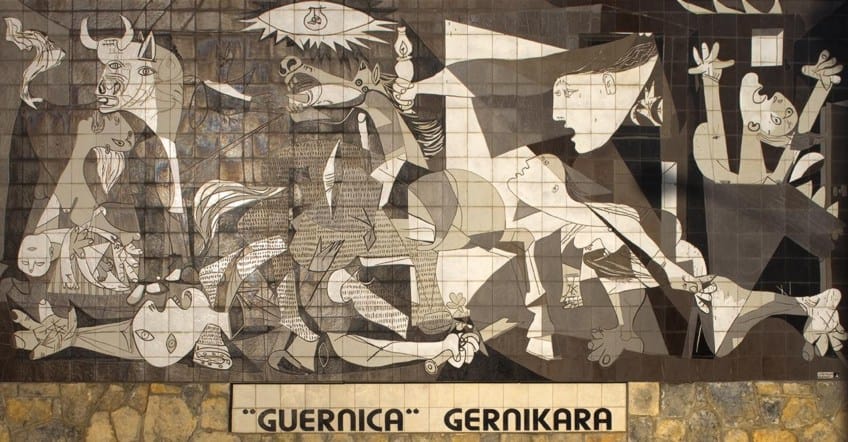
The Nazi attack, which took the lives of many women and children shocked the artist, and even though he would never go back to his birth country to live, he memorialized the injustice that happened in Guernica. At this stage in his career, he had established the “Picasso style”.
He was actively busy incorporating the influences of his African period and the formal Cubist techniques into a completely unique style of painting.
After the Guernica painting toured Europe, Picasso was clear that the painting was to remain in the MET until Spain could re-established a democratic republic. Only 10 years after the artist’s death did Spanish negotiators finally manage to get the art of war mural returned home.
Contextual Analysis of the Guernica Painting: A Brief Socio-Historical Overview
The scared town of Guernica in Spain. It is situated in Basque Country which is in Biscay province. This small town was seen as the northern stronghold of the Republican opposition crusade during the Spanish civil war. This made it a very effective target. Communists, Socialists, Anarchists, and more made up the Republicans.
All of these groups had different understandings of government and the outcomes they wanted out of the war. All of them, however, were resisting the Nationalists.
The Nationalists had General Francisco Franco as their leader. This antagonizing group was also split amongst themselves but not to the extreme extent of the Republicans. They wanted to return Spain to its perceived former glory and strived for the golden hey-days of their country that was based on law, tradition, and order, and with Catholic family values at its center. German airplanes of war coming from the Condor Legion bombed Guernica at around 16:30, Monday the 26th of April 1937.
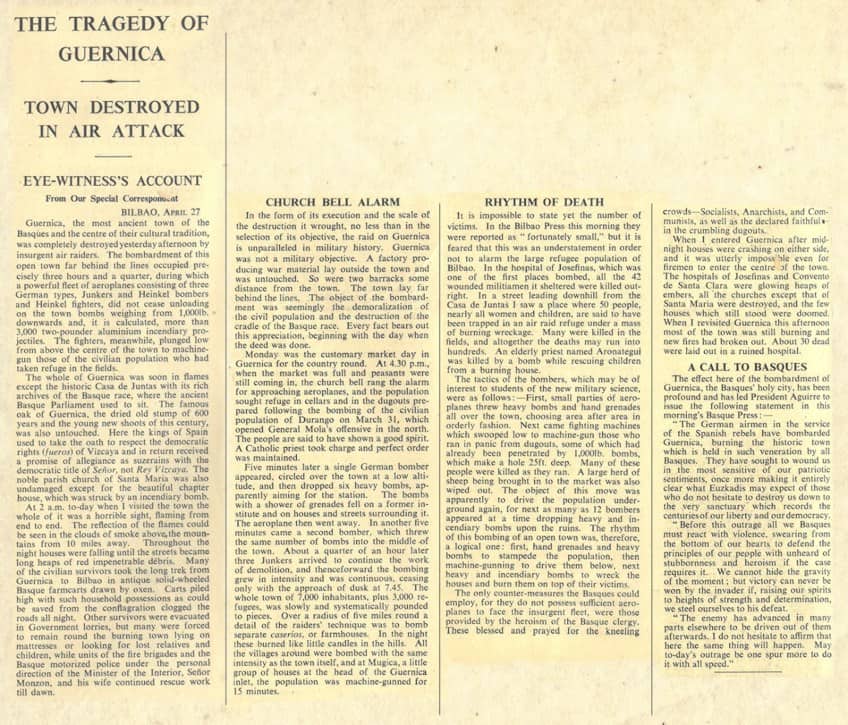
Colonel Wolfram von Richthofen was the commander of this mission that had bombs rain down on the small town for about two hours. The German army, led by Hitler at the time, had given their support in the form of bombs, planes, and soldiers for this coup. The Germans used the Spanish civil war as a chance to try out their new weapons and strategies. These tactics would later be applied to the attack on Blitzkrieg. The Guernica painting is the art of war.
It is Picasso’s response to this tragedy and the painting’s fame that led to the town of Guernica becoming a symbol of the brutalities of the Spanish civil war.
Formal Analysis: A Brief Compositional Overview
A lot of the emotional power of this painting comes from its staggering size. The enormous 3,49 x 7,77-meter mural feels like it wraps around you when viewed. The larger-than-life forms of movements and figures reference a lengthy tradition of European history paintings. However, the mural-size canvas is different from the classic European paintings as it challenges war instead of accepting it. Picasso was horrified by the tragedies that took place in Spain, and it is evident in this painting he completed in a few weeks.
Visual Analysis of Guernica by Picasso
A woman screaming with her head thrown back in the far-left corner is holding the body of her dead child. This image of the grief-stricken woman holding the lifeless body of her child is a chilling depiction of pain and grief. She is one of the most calamitous and upsetting images in the painting. The head and a part of the body of a big white bull are painted to her right. This bull seems to be the only calm and unharmed figure in all of the destruction.
Underneath the crying woman, there is a man on the ground. His arm is severed, and his maimed hand gripping a shattered sword. We are not sure if he is already dead or still dying.
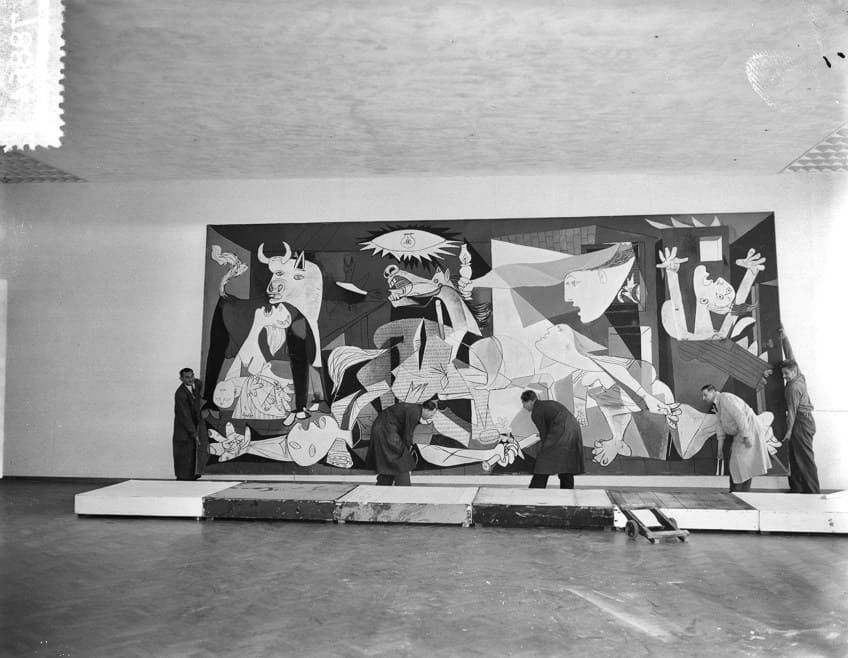
Of this man, we can only see his head, arm, and hand. The rest of his body is concealed and distorted by overlapping shapes. Right in the middle of the painting, we can see a spooked horse wrenching with its mouth open in pain. The horse also seems to be screaming, the side of its body impaled by a spear. On the right side of the painting, there are three more women. The one is rushing onto the scene of the painting. Her eyes are fixed on a shining light bulb at the top of the composition. Her legs are made grotesque by the distorted way Picasso painted them.
Another woman leans out of a burning house’s window, her head is enraged and her face is panicked. Her disproportionate arm is clasping a lamp outside of the window.
The third woman is trapped in this burning building. She is screaming in terror as her fate befalls her. All the women’s eyes are contorted, conveying their utter hysteria. Their mouths are open as if screaming and grasping for their last breath at the same time. The mural also has some hidden images in it. A skull superimposed over the body of a horse is one. Another one is a bull that is formed from a horse’s bent leg. In the horse and bull’s mouths, their tongues have been replaced by daggers.
Color and Light
Guernica by Picasso is a mixture of rural and epic painting styles. While Picasso was painting Guernica, he commissioned another artist to take pictures of his process. It is believed that these pictures influenced him to change the color palette to resemble black and white photographs. He also made the color more striking, adding more contrast.
By discarding bright colors for a simple color palette, Picasso added to the drama of the scene. The painting has a reportage quality and reminds of photographic records of the war.
As Picasso read about the bombing of Guernica in a newspaper, he decided to add forms suggesting torn newsprint in the painting. It can be seen as the horse’s armor. The influence of the black and white photograph enhances the feeling that you are looking at terrible news in a newspaper. Besides the absence of color, the harshness of the effects of war is also emphasized by Picasso’s decision to use house paint. He did this to ensure that the painting has almost no glow.
This matte paint finish, along with the gray tones, the white, blue, and black colors used sets a simple yet clear feeling in the artwork.
Perspective and Forms
The chaotic forms and movement in the painting make it very hard to decipher. What is striking at first glance is how full the painting is with death and people busy dying. When you focus for longer, figures and recognizable forms start to emerge.
However, it is not clear whether the scene is taking place indoors or outdoors or whether this disaster struck at night or during the day.
All the forms exist on one plane and on numerous planes at the same time. In a typical Cubist style, Picasso painted the devastating scene in a way that completely shatters perspective and adds to its overwhelming effect. Two-dimensional and flattened forms are combined with profile views of the faces.
Besides the Cubist motifs of warped perspective and the multiplicity of forms, Picasso also incorporated Surrealist distortions of proportion.
The combination of these styles was something he was developing at the time. What is brand new in this painting, is the adoption of child art styles. Picasso oversimplified the forms and signs. Even though strips of color in various tones overlap the outlines of the figure and animals, the subject is unavoidably clear.
Guernica Meaning and Subject Matter: A Spanish Civil War Painting
The tragedies of war are the subject matter of Guernica. It depicts the suffering war imposes upon innocent individuals, civilian women, and children. The entire painting is seen as a symbol against war and an expression of peace. The meaning Guernica could hold differs a lot and often contradict one another. These varying interpretations also apply, for example, to the two predominant elements in the mural: the horse and the bull.
The Bull and the Horse
Patricia Failing, an art historian, stated that both these characters are important to Spanish culture. Picasso famously used these characters in his paintings to play different roles. The fact that Picasso himself changed the meanings ascribed to the bull and the horse symbols from painting to painting, makes the understanding of what it means in Guernica hard. It is like these two characters dance a complex dance throughout Picasso’s career.
Some art critics and historians have warned viewers not to trust that Guernica only holds a political message.
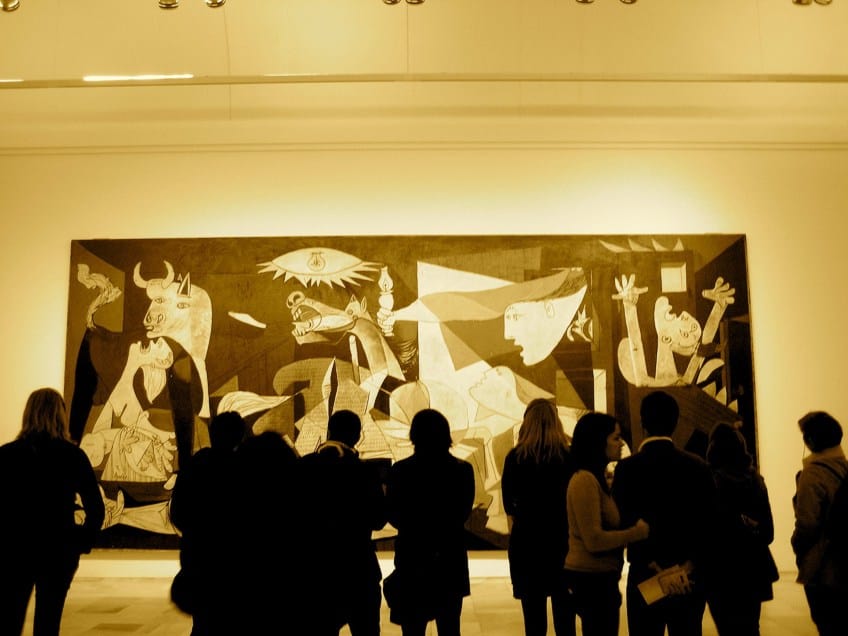
The bull for example, which in this Spanish civil war painting is interpreted as destruction, has previously featured as Picasso’s ego in the artist’s other work. That being said, it makes more sense for the bull in Guernica to represent the attack of fascism. Picasso has been reported to say that it symbolizes darkness and brutality.
He is also documented as having explained that the horse conveys the people of the town of Guernica.
The Minotaur and the Harlequin
The Minotaur and the Harlequin are also featured in the Guernica painting. Irrational power is symbolized in the form of the Minotaur and dominates the left side of the artwork. The Harlequin is a little hidden component and can be seen just off the center to the left. It is crying. Picasso painted its tears in diamond-shaped forms. Traditionally the Harlequin represents duality. In Picasso’s iconography, it is seen as a mystical symbol. It has power over life and death.
Picasso might have added the Harlequin to balance all the death he painted in the mural. It is possibly the only sign of hope and could symbolize the circle of life.
The Process Behind Picasso’s Guernica
Picasso’s Guernica was created soon after the bombing of the town. The Guernica painting was a commissioned work that Picasso started creating before the terrible incident of war happened in his home country. After he was made aware of the events, he deserted his original idea on 1 May 1937. He started painting Guernica instead of this mural for the Paris Exhibition that would take place in 1937. The work was tasked by the Republican government of Spain at the moment.
The disinterested and uninspired feeling Picasso had had towards the previous idea for this work (which he had been trying to figure out for a couple of months) disappeared very quickly.
The Reception and Influence of Guernica by Picasso
Even though this painting is now seen as Picasso’s most politically powerful work of art, it got little attention at the unveiling of the Paris Exhibition in the summer of 1937. It only later got its acknowledgment as a powerful symbol that shows the devastation of war on blameless lives. After the Paris Exhibition fair, the Spanish Republican forces sent the painting on an international tour. This tour was meant to create awareness of the war as well as raise funds for Spanish refugees.
For 19 years, Guernica traveled around the world until it was returned to the Museum of Modern Art in New York for safekeeping. This world tour led to the painting becoming famous.
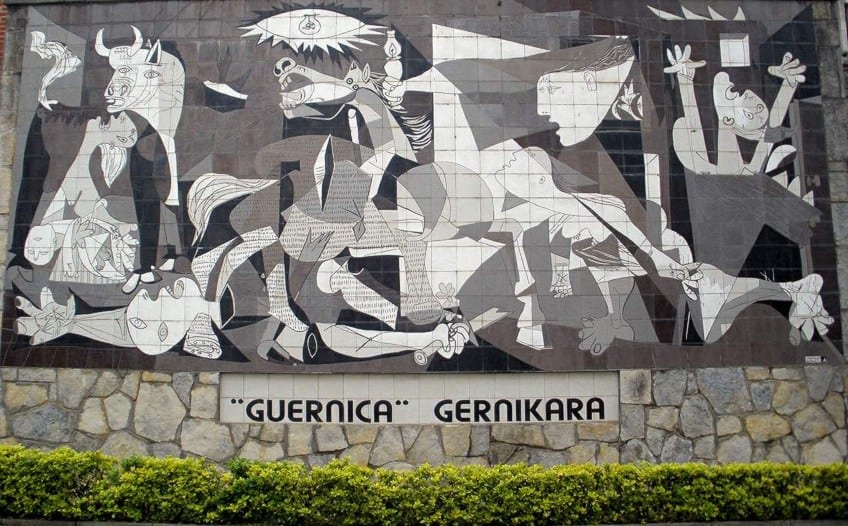
The painting kept the memory of the Basque town alive and became a protest beacon. During World War II, Picasso was living in Paris occupied by the Nazis. Apparently, a Nazi officer that was visiting his apartment once saw a photograph of the Guernica painting. He asked Picasso if he had created that, to which he responded, “No, you did.”
An artist and anti-war activist defaced the painting in 1974. Tony Shafrazi’s protest consisted of him defacing the artwork with red spray paint.
The curators of the Metropolitan Museum of Art in New York, where the painting was on show at the time, quickly cleaned it up. Shafrazi was arrested and went to jail on charges of criminal mischief. Shafrazi argued that the words “kill all lies” – which he sprayed onto Picasso’s Guernica – were meant to reactivate the artwork.
Guernica is a moving and very sad painting. Never before this painting was created, were the horrors of war shown so clearly. It has become a symbol of anti-war art and has moved so many people throughout the years. Painted as a reaction to the bombing of the town of Guernica, this Spanish civil war painting is still relevant today in a world polarized and still at war. It reminds us of the injustices of war and the unnecessary sorrow it creates.
Frequently Asked Questions
Why Did Picasso Paint Guernica?
On Monday, 26 April 1937 at 16:30, German warplanes bombed the sacred town of Guernica in Spain. Picasso was shaken by the devastation of this attack against the Republicans. At the time, he was working on a commission for the Republicans to be exhibited at the Paris Exhibition that would take place in 1937. Picasso abandoned his original idea and started creating Guernica in memory of the innocent lives claimed in the bombing.
Why Is the Guernica Painting Famous?
When it was exhibited at the 1937 Paris Exhibition, Guernica did not receive so much attention. It was only after the fair when the Spanish Republicans arranged for it to tour around Europe, that it became famous. By that time, the world was wrought with tension building up toward the Second World War. Guernica became a recognized anti-war symbol.
Where Is the Guernica Painting Housed?
Picasso did not want the painting to go to Spain before the Republican government managed to reestablish democracy. For years it was housed at the MET until Spanish negotiators managed to get the mural returned home 10 years after the artist’s death.
What Is Guernica’s Meaning?
Guernica depicts the unnecessary death and destruction that happens during war. It illustrates the hopelessness of innocent lives that are affected by big political powers. Picasso uses various symbols to create a timeless image of the violence waged against beasts and humankind.
Nicolene Burger, a South African multimedia artist and creative consultant, specializes in oil painting and performance art. She earned her BA in Visual Arts from Stellenbosch University in 2017. Nicolene’s artistic journey includes exhibitions in South Korea, participation in the 2019 ICA Live Art Workshop, and solo exhibitions. She is currently pursuing a practice-based master’s degree in theater and performance. Nicolene focuses on fostering sustainable creative practices and offers coaching sessions for fellow artists, emphasizing the profound communicative power of art for healing and connection. Nicolene writes blog posts on art history for artfilemagazine with a focus on famous artists and contemporary art.
Learn more about Nicolene Burger and about us.
Cite this Article
Nicolene, Burger, ““Guernica” by Picasso – The Iconic Spanish Civil War Painting.” artfilemagazine – Your Online Art Source. January 9, 2023. URL: https://artfilemagazine.com/guernica-by-picasso/
Burger, N. (2023, 9 January). “Guernica” by Picasso – The Iconic Spanish Civil War Painting. artfilemagazine – Your Online Art Source. https://artfilemagazine.com/guernica-by-picasso/
Burger, Nicolene. ““Guernica” by Picasso – The Iconic Spanish Civil War Painting.” artfilemagazine – Your Online Art Source, January 9, 2023. https://artfilemagazine.com/guernica-by-picasso/.


